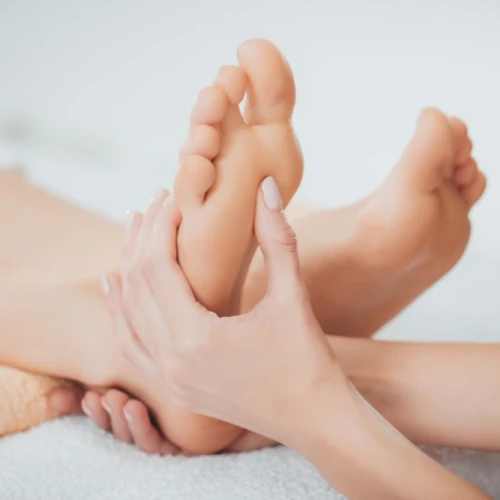Anatomy and role of the feet1, 2
The foot has three sections: the forefoot, midfoot and hindfoot. There are 26 bones and 17 joint in the foot, making it one of the most complex organs of the musculoskeletal system. Feet are involved in all aspects of walking and moving about, and bear the entire weight of our body. Feet play a role in shock-absorption, stability, moving forwards and landing through the coordination of various joints, tendons and ligaments.
Why should you have a foot massage?3
Standing for long periods, wearing too tight or loose shoes, wearing heels, carrying heavy loads, sports-related injuries and knocks... Feet are often severely tested. This is why regular massages can help you care for your feet.
Massages can be relaxing but can also be therapeutic when they soothe specific pain. The benefits of foot massages include:
- Stimulating venous return, which can alleviate the sensation of heavy legs;
- Relaxing tense muscles;
- Reducing pain associated with various foot disorders such as plantar fasciitis or heel spurs;
- Relieving tension in the body.
Foot reflexology to release the body’s self-regulating abilities4
Foot reflexology is an ancient manual practice that considers feet as a miniature representation of the human body. Each reflex point corresponds to a specific organ, gland or part of the body. In reflexology, rhythmic pressure is applied to these reflex points to identify tension and restore balance to the corresponding parts of the body. It is a technique that provides deep relaxation, comfort and helps relieve stress.
Shiatsu to regulate energy pathways and provide relaxation5
Shiatsu (the Japanese word for finger pressure) is a manual practice that regulates energy pathways and provides relaxation. It has been practised for thousands of years in the Far East. It involves stretching and applying pressure to the whole body, most often with the fingers, especially the thumbs and palms. Shiatsu is used on the feet to reduce both physical and psychological tension, and help balance the overall energy system.
Foot massages for well-being
You don't need to see a reflexologist, or someone trained in Shiatsu to have a foot massage. You can also visit a wellness centre that offers different types of foot massage such as Californian massage, hot stone massage, Swedish massage, Ayurvedic massage, etc. Unlike reflexology and Shiatsu, these massages do not target specific points but promote deep relaxation by massaging the entire foot, applying varying degrees of pressure according to the type of massage.
Foot self-massages
You can also perform self-massages on your feet. In a seated position, place the foot you are going to massage on the knee of the opposite leg. Start by applying gentle pressure then gradually increase the pressure. Start the massage with the heel area and end with the toes. Using vegetable oil for the massage makes your hand movements easier and also provides intense moisturisation of the feet. To massage the bottom of your feet, perform circular movements with your thumbs. At the same time as you are massaging the arch of your foot, apply pressure with your four other fingers to the top of the foot. When you reach the toes, stretch them one by one before massaging them - applying upward pressure with your thumb and index finger.


